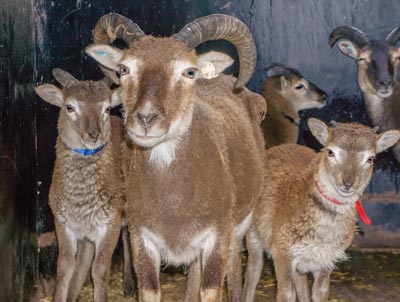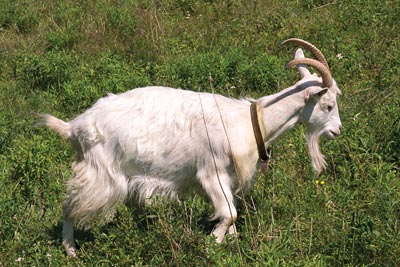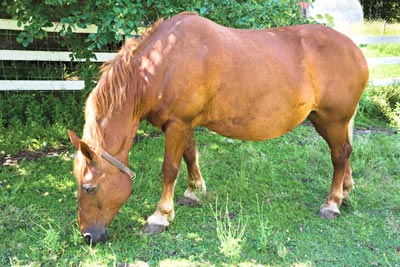 |
| The Soay sheep in the foreground is Jenny, with her twins born this spring; in the background is Juliana, with her single born this spring. Wayne Myers photo |
 |
| A 75 percent Icelandic cashmere dairy goat, the result of an Icelandic upgrading breeding project at Beau Chemin Preservation Farm. Wayne Myers photo |
By Jo Ann and Wayne Myers
Beau Chemin Preservation Farm (BCPF) in Waldoboro, Maine, is a small farm with a mission to preserve “yesterday’s breeds for tomorrow’s needs.” The farm is MOFGA-certified organic for PYO berries and fruit, and for seedlings, hay, pasture, ducks and eggs. A major product is wool for handspinners.
We raise 14 endangered livestock breeds. Why that focus? We could conserve endangered livestock breeds for sentimental and aesthetic reasons, e.g., because “our grandparents raised the breed” or “they’re pretty,” but important agricultural and environmental reasons exist for conserving endangered breeds.
Many endangered breeds of livestock are historic. Unlike breeds developed for monoculture livestock agriculture, that is, breeds designed for specific production objectives such as fast growth for meat or copious amounts of milk, traditional “landrace” breeds are isolated to a local area and developed because they met the needs of sustainable, multipurpose farms and the physical environment. Farmers started with whatever breed was available, and isolation combined with farmer selection resulted in a genetic package unique to the local area. These farms needed livestock adapted to local feed and weather, and that met farm and family needs and local market conditions. The livestock provided the farmer with multiple products and services and helped the farm better cope with the certain uncertainty of farm life. As contemporary farming transitions to local food production and organic farm principles and enhances those practices with the principles of permaculture, livestock breeds that can cope with natural conditions and produce multiple products become really important. Farmers want and need options.
A breed is simply an animal that breeds true; that is, the offspring reliably resemble the parents. Such genetically uniform breeds can be divided into industrial, standardized and landrace. In standardized breeds, breeding pairs are selected to produce observable characteristics. Landrace breed origins are discussed above. Feral breeds, on the other hand, are made up of domesticated livestock that escape the farms, breed freely without human selection, and develop traits over generations that are adapted and unique to the physical environment.
In contrast, crossbreds and “typey” animals (animals typical of a breed) are genetically variable.
We raise Soay sheep, a good example of a feral breed. The largest population of Soays were domesticated sheep that were likely dropped off by Vikings on islands off the northern coast of Scotland, where islanders used the animals for meat and fiber but did not domesticate the Soays. The largest populations of Soays still live on now-uninhabited islands and are part of a multi-part research program, since their ancient genetic package and isolation offer great research possibilities.
In the United States, examples of feral livestock include the Spanish Mustang horse and San Clemente goats.
Industrial breeds are developed to meet livestock monoculture goals. They may or may not be able to survive and breed in the natural environment. Broad-breasted white turkeys and Holstein cows are two recognized examples.
Breed development has a long history. Standardized breeds go back about 200 years. The Englishman Robert Bakewell was the first to develop and standardize a breed, the Leicester Longwool sheep, in the 1700s. These sheep, designed to do well in wet lowlands, provided fiber for coats and carpets and were large-bodied, thrifty and docile.
At our farm we focus on the most critically endangered breeds, figuring that a small farm can best contribute by adding just a few animals to a very small population.
 |
| Cindy, a Suffolk Punch draft horse, retired from Paul Birdsall’s Horsepower Farm in Penobscot, Maine, and has been living at Beau Chemin since fall 2015. Fully trained as a farm draft horse, she was training some of Birdsall’s young Suffolk Punch horses before her move and is still available to Birdsall in case he needs her occasionally. Wayne Myers photo |
The Livestock Conservancy (www.livestockconservancy.org) classifies conservation categories by annual breed registrations: Critical means 200 registrations; Threatened, 1,000; Watch, 2,500; Recovering, more than 2,500. We raise Leicester Longwool, California Variegated/ Romeldale, Soay and Shetland sheep; Oberhasli and Icelandic dairy goats; Suffolk Punch draft horse; and Dutch Hookbill, Welsh Harlequin, Khaki Campbell, Cayuga, Buff, Silver Appleyard and Indian Runner ducks. We no longer breed Shetlands, which are classified as a Recovering breed. Our egg-laying duck breed varieties shift over the years. We have had a Randall cow and eight endangered chicken breeds.
Among the conservation breeding programs on our farm is upgrading to establish the Icelandic cashmere dairy goat in the United States. Icelandic goats were likely brought from Norway to Iceland at settlement about 1,100 years ago. Nearly extinct in the late 1800s, the population grew to 3,000 in 1930, dropped to a low of 100 in the 1960s, and is now about 700. In Iceland, they are used for meat and dairy and a little cashmere. Cashmere fiber has to be sent to Europe for processing, and Iceland’s iconic fiber is Icelandic sheep wool. To preserve its farming history, Iceland prohibits importation of other breeds of sheep, goats, poultry and dairy cows.
The United States prohibits importation of ruminants except for slaughter, but importation of semen is permitted. We began with Oberhasli dairy goats with ancestry similar to Icelandics. Does are bred via artificial insemination (AI) using Icelandic semen. Female offspring (50 percent Icelandic) undergo AI to produce kids that are 75 percent Icelandic. This process will be repeated for seven generations, resulting in goat kids that are over 99 percent Icelandic. We are now three generations into the process. The current, 88 percent Icelandic goats closely resemble Icelandics, but four more generations are required before these goats are truly genetic members of the Icelandic breed.
Given that AI has a low success rate, that seasonal breeding means only one breeding of yearling females annually, that 50 percent of all kids are bucks and bucks that have a low percentage of Icelandic genes aren’t useful to our breeding program, this project requires time and perseverance. On the upside, we are getting good fiber from 75 percent Icelandic goats, and although we are leaving kids on the does, we look forward to experimenting with this goat milk in a few years. Also, males with a higher percentage of Icelandic genes can be used by other farms to jumpstart their upgrading.
A big reason for this conservation program is to get these genetics in another geographic area. Iceland’s livestock conservation and disease control strategies are model programs, but should a major disease outbreak occur in Iceland resulting in mandatory slaughter, the only available genetic source for Iceland goats would be frozen semen and embryos. While Iceland probably will not experience a country-wide disease outbreak given its strong disease prevention programs, a disease outbreak is devastating to all livestock and especially to endangered breeds. The 2001 foot-and-mouth disease outbreak in Great Britain resulted in mandatory euthanizing, including herds and flocks of endangered breeds. The 2015 avian flu outbreak in the United States resulted in euthanizing millions of poultry.
Any time humans get involved in breeding animals, they make choices. Basing choices on a few observable characteristics alters the genetic package in many ways that cannot be anticipated. Breeders don’t know what pieces of the genetic package are lost. Characteristics lost to selective breeding cannot be reclaimed, and an entire breed may be damaged.
Conservation breeding is interesting, fun and demanding. It is pretty easy to look at our sheep breeds, all of which produce fiber, and wonder what we’d get crossing Shetlands and Leicester Longwool. Humans are imaginative, and we’ve produced good and harm by meddling.
Given the small scale of our farm, we could easily end up with a genetic bottleneck by breeding relatives. Consequently, we have to make breeding choices by thinking of our farm as a subset of all farms raising the same breed. We have to replace breeding stock more often and breed just one generation at a time.
The advantages of endangered breeds can be significant. Our Soay sheep resist parasites. Soays are likely the progenitor of all northern European short-tailed sheep with a history of about 3,000 years. This is probably the only U.S. sheep breed registered in Great Britain, where our Soay sheep are registered by the Rare Breeds Survival Trust (www.rbst.org.UK). Soays could be used by other farms to introduce parasite resistance by crossing, much like Jerseys are used to add milkfat to Holstein herds. For this application to continue, other farmers need to conserve the Soay genetic package. Functional uses for endangered breeds of livestock change over time, so conserving in anticipation of future needs is wise. The Livestock Conservancy, the USDA National Animal Germplasm Program (www.nrrc.ars.usda.gov), Swiss Village Farm (www.svffoundation.org) and Smithsonian Conservation Biology Institute identify conservation priorities and provide scientific and technical support.
Livestock breed diversity is as important as biologic diversity in wildlife, plant life, vegetable, fruit and flower seeds. Domestic livestock live in our artificial farm environments. We envision the community around the farm as a biologic system – interdependent, synergistic, evolving; composed of rural villages, developed and undeveloped landscape, government and civic organizations, local markets, the physical environment. Sustainability requires using organic and permaculture principles. The farmer may want to make livestock breed choices in this broader context.
Maine and New England have many conservation breeders, although they may not think of themselves in that way. Instead, the breed choices these farmers make are the breed choices that have made sense for generations and still fit their farm goals. These farmers are maintaining these breeds for practical reasons reflecting their success in the New England farming environment. These include Milking Devon and milking Shorthorn cows, Buff Orpington chickens and old style Morgan horses.
Come visit sometime: Beau Chemin Preservation Farm, 1749 Finntown Rd., Waldoboro, ME 04572; www.beaucheminpreservationfarm.com; [email protected], 207-691-8164 or 207-596-1161.
About the authors: Jo Ann and Wayne Myers own Beau Chemin Farm in Waldoboro. Jo Ann also chairs MOFGA’s Public Policy Committee and is secretary of MOFGA’s board.
